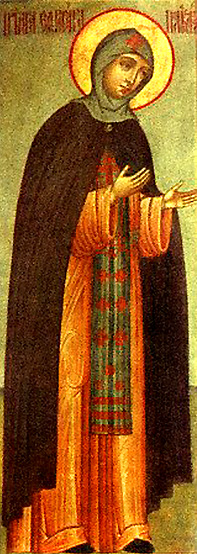
Confessions of a Cross-dressing Nun

After St. Euphrosina’s father leaves her cell, thinking he is leaving the cell of a (to him) random cloistered male monk that the abbott (inexplicably) says will comfort him in the loss of his daughter, and after Euphrosina watches as he “cryes,” his “teares … gushing, like two streames that flow / From a high fountaine to some place below” (page 45, lines 1621-25), the poem’s speaker asks “Sweet Euphrosine, how can’st thou leave distrest thy father deare, with sorrow so opprest?” (1698), and Euphrosina finally gives in to weeping, which she had held back while her father was in her cell. Not only does she let loose tears–having “more libertye to weepe and mone” (1779)–she also begins losing blood: “A vomiting of blood so dangerouslye / That with it she was almost like to dye (1780-81). To overcome this obstacle, of perhaps guilt-induced bodily releasement of tears and blood, she takes “the weapons of our Saviour’s passion / To overcome all crosses and temptation” (1798). It is after this point that her (potential) hallucination begins, launching into the next twenty-ish pages including spiritual time travel that culminates in her death and finally, asking her father to whom she lied and allowed to grieve her in her own presence, to provide money to this monastery and to pray for her. The poem returns to its earlier concern (obsession?) with describing earthly treasures in great quantity and detail, when Euphrosina visits the baby Jesus bringing “all her ornaments and Jewells … / And those rich robes, … / And tapestryes” (1829). Then, as note #259 states, “While Christ’s disciples sleep during this pivotal moment, Euphrosina attends and comforts Christ in his agony” (page 55); she “With him … goes to Pilate” (line 2050), “from thence to Herode’s Pallace” (2055) and finally, the speaker tells us, like the Oxy-clean spokesman, “but wait, there’s more!” “But heere’s not all, she must yet further goe / To see her deare lord suffer greater woe” (2074). She then accompanies Mary to visit her dead/resurrected son, and travels back in time to see Solomon in all his glory (who appears often in this poem along with images of lillies, from Jesus’ parable of the lillies of the field) (page 61) and finally, to the Garden of Eden (top of page 62) before she dies saying she has “run my race and won the Crowne” (line 2365). In this poem, then, my interpretation is that her spiritual time travel, her meditation and/or hallucination after she vomits blood and tears, constitutes this “race” and the Crowne becomes death and access to heaven which is described as having all the jewels and material objects she earlier renounced. Before science fiction, the genre rife with time travel, there was Charles Dickens’ Christmas Carol which took Scrooge on an elementary form of time travel through his own life. Here, 200 years-ish, Evelyn’s poem takes Egyptian St. Euphrosina time-traveling through major biblical events from the confines of her self-chosen cell.
Works Cited
Catherine Magdalen Evelyn, “To the Most Glorious … Saint Euphrosina,” The Life of Blessed Sainte Euphrosina, lines 1-1505

